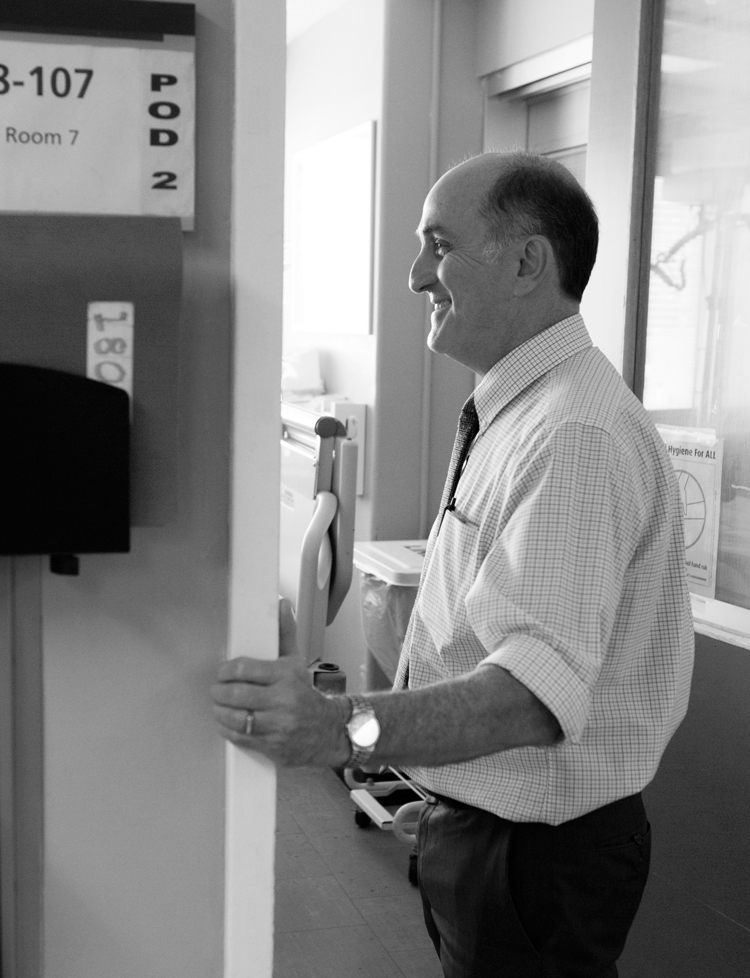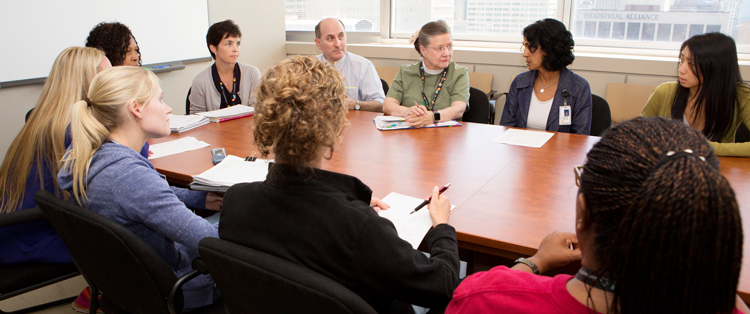
 Above: Dr. Stephen Lapinsky
Above: Dr. Stephen Lapinsky
Written By: Marcia Kaye
Photos By: John Packman
Dr. Stephen Lapinsky was momentarily puzzled when a pregnant woman, coming into the hospital in labour, gave him a smile of recognition across the lobby. He wasn’t sure who she was — until he recognized her husband, who was accompanying her.
The woman had spent several weeks in the intensive care unit on life support after contracting a deadly influenza during her pregnancy, and her husband visited often. She had recovered and was now back in the hospital a month later, but this time to give birth. “That was nice,” says Dr. Lapinsky with characteristic understatement.
Dr. Lapinsky didn’t recognize the woman at first because he generally sees people at their very worst. He’s the Director of the Intensive Care Unit (ICU) at Mount Sinai Hospital, part of Sinai Health System. While most people have had some experience with hospitals, the majority have never been in an ICU. “Many people don’t really understand what the ICU is,” he says. Some confuse it with the emergency room or the operating room, while others view it only as a place of mystery, with complex machines beeping behind closed curtains.
That’s why Dr. Lapinsky and his team want to shed some light on what actually goes on there. “Basically, the ICU is for the sickest patients in the hospital,” he explains. “It’s ongoing support while a patient gets better.” Patients receive more specialized treatment and closer monitoring than in a regular hospital bed. There’s usually one nurse for each patient. The 16-bed unit treats about 900 patients a year. Stays range from 24 hours to a month or more, the average being four or five days.
“We get more obstetrical ICU patients than pretty much any other site in the world,”
- Dr. Stephen Lapinsky, ICU Director
Some patients have had a heart attack or stroke; have undergone major surgery and need extra care; have had a medical or surgical complication or require advanced support such as round-the-clock dialysis. Since next-door Princess Margaret Cancer Centre has no ICU of its own, it sends the most vulnerable patients, such as those who have just received a bone marrow transplant, to Mount Sinai’s ICU via a connecting bridge. Patients may also include pregnant women with serious conditions or women who have just gone through a life-threatening childbirth. “We get more obstetrical ICU patients than pretty much any other site in the world,” says Dr. Lapinsky.
Two common conditions among ICU patients in general are septic shock, a body-wide infection resulting in multiple organ failure, and acute respiratory distress syndrome (ARDS), a life-threatening lung condition that requires mechanical ventilation. About two-thirds of all ICU patients are on ventilators, also called life support. Fortunately, 80 to 85 per cent of all ICU patients get well enough to leave the ICU.
One of them is Dr. Richard Kirsch, a surgical pathologist at Sinai Health System who himself became an ICU patient in 2007 when flu symptoms quickly escalated to ARDS. He was kept alive through a method of ventilation called high-frequency oscillation, one of the ICU’s areas of research and expertise. Dr. Kirsch recovered and returned to work in the hospital. “He’s happy for us to bring families down to talk to him to show that you can get better, or to discuss the ICU stay,” says Dr. Lapinsky.
 Above: Members of the ICU team gather for weekly "bullet rounds" to address the needs of patients
Above: Members of the ICU team gather for weekly "bullet rounds" to address the needs of patients
While TV hospital dramas often show ICUs as places that keep families out, Mount Sinai’s ICU welcomes family members anytime. Visiting hours are 24/7, and have been that way for 20 years. Families are welcome to listen in during the medical team’s morning rounds, stay during procedures and even be present during resuscitation if they choose to. Research has shown that family presence can offer comfort and reduce anxiety in both patients and family members.
Research, like most of what happens in the ICU, involves teamwork among colleagues in various disciplines. “We’ve been doing multidisciplinary clinical research in the ICU for the last 20 years,” says Dr. Sangeeta Mehta, who cares for patients in the ICU and is also the ICU’s Research Director. “Our ICU is recognized nationally and internationally for the quality and the importance of the research we do. It’s very much a team effort.”
Clinical staff work alongside research personnel and other health-care professionals, as well as fellows and residents, to do research that is focused both on improving outcomes for ICU patients, and on better understanding the perspectives and needs of family members. Dr. Mehta’s research deals with managing issues around sedation — “how to relieve pain, anxiety and inability to sleep, how best to give sedatives and pain drugs to patients and the impact of these drugs and how we can get people off breathing machines sooner,” she explains — as well as delirium. A common condition in hospitals, delirium is particularly traumatic for ICU patients, and is associated with worse outcomes. Dr. Mehta and the ICU team are looking at how to prevent or improve treatment for delirium.
Though always looking ahead to improve care for future patients, the ICU team dedicates itself with equal fervor to each and every patient. Morning rounds take place every day, right by each patient’s room. The bedside nurse updates the rest of the team, including the attending physician (one of six, who rotate weekly), several fellows and residents, a pharmacist, a respiratory therapist, a physiotherapist and a dietitian, and they discuss treatment for that day. The team also includes two other important people: a chaplain and a social worker, who offer intense emotional, psychosocial and spiritual support to families and facilitate meetings between the family and the full medical team. “They’re really our conduit to the families,” says Dr. Lapinsky.
Just as an ICU is a foreign concept to many, so is a chaplain, says Reverend Nola Crewe, ICU Chaplain, who takes care of all the spiritual needs in the ICU. Some think she’s there to baptize people or even to convert them. But actually, her role is to provide a caring, compassionate presence, encourage families to talk about their concerns and generally take the “tense” out of “intensive care.” Plus, she adds with a grin, “I’m an authority on all the best restaurants in the neighbourhood, and I know where the better washrooms are located.”
“We’ve been doing multidisciplinary clinical research in the ICU for the last 20 years. It’s very much a team effort.”
- Dr. Sangeeta Mehta, ICU Research Director
Her role often overlaps with that of social worker Andrea Moore. But if a family member requires help navigating the health-care system or needs a letter written to explain to their boss why they’re missing work, Andrea will do it. And if patients or families have a religious request — a kosher diet, prayers for a patient, communion at the bedside — Rev. Crewe will arrange it. An ordained Anglican minister, she has even officiated at marriage ceremonies involving critically ill patients.
Rev. Crewe goes to each new patient’s room to connect with family members, gives them a leaflet about what to expect in the ICU and offers her card, letting them know she’s there to talk, or to listen, anytime. When a lengthy patient stay is anticipated, she gives the family a journal so they can record the patient’s progress, jot down questions for the doctor, write thoughts or prayers, encourage visitors to add their well wishes or communicate daily events to their unconscious loved one, such as, “The Toronto Maple Leafs won last night! I’ve taped the game so you can see it when you get better.” Also, when patients do start to get better, the journal — an initiative supported by the Mount Sinai Physicians Campaign Fund — can help their recovery by filling in the memory blanks of their ICU stay.
It’s a reality in the ICU that, unfortunately, some patients will not get better. Rev. Crewe makes herself available to talk about death with families and prepare them for the removal of life support. Sometimes, she says, the healing that happens is not about the patient’s body but about the family relationships. She tells of a woman who, after a 10-year estrangement from her whole family, flew home to visit her ailing father in the ICU. The original rift was long forgotten, and by the time the father passed away, the family was united. “In his dying, he reminded the family of how important he was to everybody,” Rev. Crewe says, “and that led them to realize how important they were to each other.”
The current ICU is 40 years old, but there’s a new ICU in the planning, with a scheduled 2022 opening. It will relocate from the 18th floor to the fifth floor, handy to the diagnostic imaging department on that floor and closer to the operating room on the seventh floor. There will be lab testing at the bedside to assist with timely diagnosis. Negative pressure rooms with dedicated anterooms for gowning and de-gowning will prevent the spread of airborne illnesses.
The new ICU will be much more spacious. Almost all rooms will have large windows with outside views, providing exposure to natural daylight to help reduce delirium and confusion and speed recovery. The waiting area for families will be larger, too, with comfortable seating, a kitchenette, a shower and a quiet room. Dr. Lapinsky says that while “patient-centred care” has become a buzzword in hospitals, “We’ve actually been doing it for a long time.” The new ICU will help facilitate that even more.